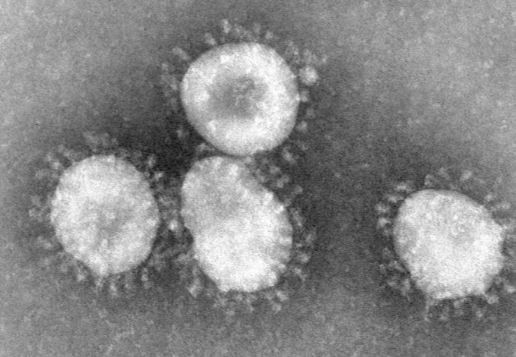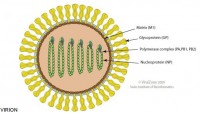IBM’s New Macromolecule: the Cure for the Common Cold and Viral Infections?
| Arthur Dominic Villasanta | | May 16, 2016 09:57 AM EDT |
Corona viruses are a frequent cause of the common cold
IBM and Singapore's Institute of Bioengineering and Nanotechnology (IBN) have developed an anti-viral macromolecule that blocks viruses from infecting cells despite the virus' mutations. This means new medicines can be developed that effectively counter the ability of viral infections to defeat medications because of their natural ability to easily develop drug resistance.
Like Us on Facebook
The partners announced their identification of a new "breakthrough macromolecule" with a unique triple-play mechanism that could help prevent deadly virus infections. The macromolecule or a very large molecule can also help prevent viral drug resistance.
The new macromolecule consists of several specialized components that create a powerful triple-play action to help fight viral infection and replication while inhibiting drug resistance. Viruses are a leading cause of sickness and death worldwide.
"We have created an anti-viral macromolecule that can tackle wily viruses by blocking the virus from infecting the cells, regardless of mutations," said Yi Yan Yang of the IBN.
"It is not toxic to healthy cells and is safe for use. This promising research advance represents years of hard work and collaboration with a global community of researchers."
The study exploits "supramolecular chemistry" or the study of large molecules designed with multiple features to help combat viral infections. The research is believed to be a first of its kind in fighting viral diseases. Using the supercomputer called IBM Watson could help further accelerate drug discovery.
The macromolecules' triple play action Yi referred to consists of attraction, prevention and neutralization.
In attraction, one specialized component of the macromolecule disables a virus' ability to infect healthy cells. Prevention means the mannose (a type of sugar) components of the macromolecule bind directly to healthy immune cell receptors to help fight viral infection, and allow the free flow of these naturally protective cells.
Neutralization sees another component of the macromolecule (the basic amine groups) neutralize the pH inside the viral cell, making it inhospitable for replication.
IBM said the triple play approach has been proven effective in treating a wide range of viruses, including those that cause the common cold. The common cold virus is caused by one of 200 types of viruses, of which four are most common.
The short-term potential for medicines based on the macromolecule could developing an anti-viral wipe or detergent. This application requires a small amount of the macromolecule dispersed in water to neutralize an entire room infected with Ebola, for example.
Potential longer-term applications could include the development of a new mode of vaccination that might help prevent a whole category of viral infections.
"With the recent outbreak of viruses such as Zika and Ebola, achieving anti-viral breakthroughs becomes even more important," said Dr. James Hedrick, lead researcher, advanced organic materials, IBM Research in California.
"We are excited about the possibilities that this novel approach represents, and are looking to collaborate with universities and other organizations to identify new applications."
By also targeting both viral proteins and host-virus interactions, the antiviral macromolecule sidesteps the normal mutations that enable viruses to escape vaccines through the onset of resistance.
Tagsmacromolecule, anti-viral macromolecule, IBM, Singapore's Institute of Bioengineering and Nanotechnology, Yi Yan Yang, Dr. James Hedrick
©2015 Chinatopix All rights reserved. Do not reproduce without permission
EDITOR'S PICKS
-

Did the Trump administration just announce plans for a trade war with ‘hostile’ China and Russia?
-

US Senate passes Taiwan travel bill slammed by China
-

As Yan Sihong’s family grieves, here are other Chinese students who went missing abroad. Some have never been found
-

Beijing blasts Western critics who ‘smear China’ with the term sharp power
-

China Envoy Seeks to Defuse Tensions With U.S. as a Trade War Brews
-

Singapore's Deputy PM Provides Bitcoin Vote of Confidence Amid China's Blanket Bans
-

China warns investors over risks in overseas virtual currency trading
-

Chinese government most trustworthy: survey
-

Kashima Antlers On Course For Back-To-Back Titles
MOST POPULAR
LATEST NEWS
Zhou Yongkang: China's Former Security Chief Sentenced to Life in Prison

China's former Chief of the Ministry of Public Security, Zhou Yongkang, has been given a life sentence after he was found guilty of abusing his office, bribery and deliberately ... Full Article
TRENDING STORY

China Pork Prices Expected to Stabilize As The Supplies Recover

Elephone P9000 Smartphone is now on Sale on Amazon India

There's a Big Chance Cliffhangers Won't Still Be Resolved When Grey's Anatomy Season 13 Returns

Supreme Court Ruled on Samsung vs Apple Dispute for Patent Infringement

Microsoft Surface Pro 5 Rumors and Release Date: What is the Latest?














